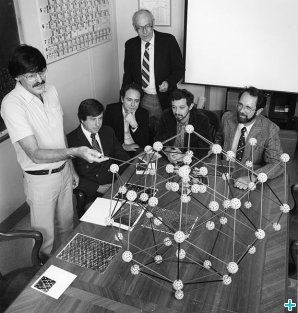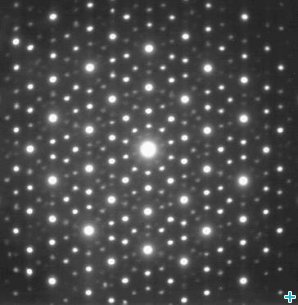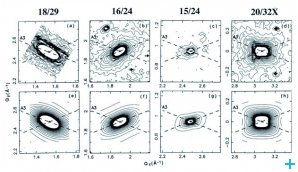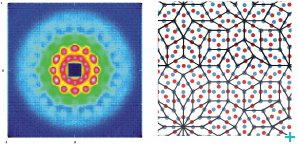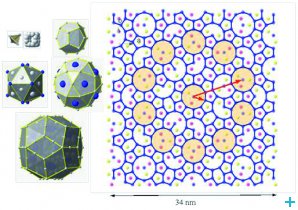The contribution of neutrons to the study of quasicrystals
Following the award of the Nobel prize in Chemistry to the father of quasicrystals, Inside NMI3 ´s Juliette Savin reviews neutrons´ special contribution to the study of these peculiar crystals.
Dan Shechtman, an Israeli scientist currently working at Technion, Israel was recently awarded the 2011 Nobel Prize in Chemistry for the discovery of quasicrystals in the early 80´s. Since then, neutrons have contributed to confirm Schechtman´s findings and helped to determine the structure and dynamics of quasicrystals.
The discovery of quasicrystals: a paradigm shift
On the 8th April 1982, in an experiment that was going to revolutionalise not only chemistry but also physics and mathematics, Dan Schechtman exposed a sample of Aluminium-Manganese (Al-Mg) alloy to a beam of electrons. The electron beam diffracted off the alloy atoms and created an unusual diffraction pattern. This pattern, unlike any other, revealed a crystal that was highly ordered, infinite, yet never repeated itself and showed a ten-fold rotational symmetry.
“10 fold???” wrote an incredulous Schechtmann in his notebook, following his stupefying finding.
At the time, a ten-fold rotational symmetry within crystals simply wasn´t allowed.
Dan Schechtman had to face a very skeptical scientific community that believed crystals could only be periodic arrays of atoms, allowing only certain symmetries that generated this periodic pattern. After much controversy, and having to leave his lab, Dan Schechtmann published his seminal paper about quasicrystals in 1984 [1], which gradually led to a paradigm shift. Quasicrystals became a new field in science, drawing from and enriching chemistry, physics and mathematics.
“When they were discovered, quasicrystals revolutionised our understanding of crystals and long range order, and ultimately of all solid-state physics,” explains Marc de Boissieu, a quasicrystal expert at SIMAP – CNRS/Grenoble-INP/UJF in Grenoble, France.
According to the classical crystallographic restriction theorem, crystals can only possess two, three, four, and six-fold rotational symmetries. The Bragg diffraction pattern of quasicrystals, however, shows sharp peaks with other symmetry orders, such as five-fold, eight-fold, ten-fold, twelve-fold or even 18-fold [4]. This can be explained by the well ordered, but aperiodic and infinite structure of quasicrystals.
Similar aperiodic patterns have been found in artefacts dating back to the middle ages, such as the Islamic mosaics of the Alhambra Palace in Spain and the Darb-i Imam Shrine in Iran, but Daniel Schechtman was the first to show that they also exist in chemical systems. “Daniel Schechtmann certainly benefitted from the fact that other scientists – the mathematician Roger Penrose and the crystallographer Alan Mackay for instance- had already investigated the subject of aperiodic mosaics and patterns in detail,” adds Marc de Boissieu.
Since then, quasicrystals have been discovered in many synthetic intermetallic systems as well as in liquid-crystals [2], polymers [3], nanoparticle assemblies [4] and micellar systems [5]. Naturally-occuring icosahedral quasicrystals, an alloy of aluminum, copper, and iron, have recently been discovered in a river bed in Russia. [6]
Neutrons and quasicrystals
Neutrons have played a crucial role in confirming that what Dan Schechtman was seeing wasn´t an artifact of the diffraction pattern. In research carried out in the USA, Europe and Japan, neutrons have helped uncover the precise atomic structure of quasicrystals, as well as their peculiar dynamics and unusual properties.
Inspired and incited by French crystallographer Denis Gratias, co-author of the 1984 paper [1], French researchers at ILL and LLB started doing structural and dynamic analysis of quasicrystals using neutrons very early after their discovery. “Denis Gratias spearheaded quasicrystal research in France and in Europe,” explains Marc de Boissieu.
Christian Janot, Jean-Marie Dubois and Jean Pannetier were among the first to use neutrons to study quasicrystals at ILL, in 1986 [7]. They used a technique called isomorphic substitution, which gives information about specific atoms in materials containing more than one atom, like alloys. They were among the first to record a neutron diffraction pattern of Al-Mn-Si icosahedral quasicrystals and their work initiated a long-term research programme on quasicrystals at ILL.
Neutrons offer a better contrast than X-rays and electrons for a number of elements, such as Lithium, Manganese or Nickel. By combining X-rays and neutrons, researchers from France, the USA and Japan were thus able to build precise atomic models of icosahedral quasicrystals such as Al-Mn-Si, Al-Li-Cu, or Al-Pd-Mn [8-11].
Using inelastic neutron scattering on three-axis spectrometers at ILL (IN8, IN14) and LLB (2T, 4F) Marc de Boissieu et al., in collaboration with European and Japanese teams, could study the lattice dynamics on a series of quasicrystals (i-AlPdMn, Zn-Mg-Y, decagonal Al-Ni-Co, and, more recently, the Zn-Mg-Sc icosahedral phases). Due to the long range quasiperiodic order, the atoms in quasicrystals vibrate in a characteristic way, leading in particular to low phonon heat conduction. This was shown in the first experiments and more recently by combining experimental results and atomic scale simulation in the Zn-Sc system. [10]
A Small angle scattering (SANS) study recently carried out on D11 at ILL showed the existence of colloidal quasi-crystals for the first time. These polymers evolve through self-assembly into quasicrystalline micellar structures presenting 12- and even 18- fold rotational symmetries. [5]
The neutron diffraction patterns generated by quasicrystals are usually very dense, presenting a continuum of reflections, some being much stronger than others. “This makes it difficult to work with classical single-counter detectors and really large high resolution area detectors are usually needed.” Explains Björn Pedersen, instrument scientist for RESI, a thermal single crystal diffractometer at FRM II, in Garching, Germany. “That´s why there are not that many instruments in the world where neutrons can be used to study quasicrystals,” he adds.
Diffuse neutron scattering experiments done at ILL and LLB have enabled researchers to measure what distinguishes quasicrystals from normal crystals and to identify the specific diffuse scattering signature of the quasicrystal order [12].
Because they possess a magnetic dipole moment, neutrons can be used to analyse the magnetic properties of materials, at the atomic scale. Some experiments have been carried out at single crystal diffractometers around the world to look for a possible magnetic order in decagonal and icosahedral quasicrystals. Recent studies carried out at ILL and Tokai, in Japan have shown a short range magnetic order in Zn-Mg-Re icosahedral alloys [11] and have shed light on the magnetic characteristics of quasicrystals.
Applications of quasicrystals
Intermetallic quasicrystals, like all complex metallic alloys, present unusual physical properties that can be exploited for a number of niche applications. Because they are poor heat conductors they can serve as good thermal barriers, to protect metal parts from overheating, for example. They have low friction coefficients, and trials have been carried out to replace Teflon with a quasicrystallic coating on cookware, for instance. More studies are being done to investigate this property for use in mechanical parts.
Quasicrystals are hard and brittle, but they can be used for structural strengthening, to reinforce other light alloys such as Mg-based alloys. Quasicrystals are also being studied for use as catalysers, to replace noble metals like gold or palladium.
The European Union is supporting research into complex metallic alloys, including quasicrystals, via an international network –The European Integrated Center for the Development of New Metallic Alloys and Compounds: www.eucmac.eu.
References:
[1] D. Shechtman, I. Blech, D. Gratias, J.W. Cahn, Physical Review Letters 53(20), pp 1951-1954 (1984)
[2] X. Zeng et al., Nature 428, pp 157-160 (2004)
[3] K. Hayashida et al., Physical Review Letters 98, 195502 (2007)
[4 ] Talapin, D. V. et al. Nature 461, 964–967 (2009)
[5] Steffen Fischer, et al. PNAS January 11, (2011)
[6] Bindi, Luca, Paul J. Steinhardt, Nan Yao, and Peter J. Lu Natural Quasicrystals, Science 324, 1306-1309
[7] J. M. Dubois, Chr. Janot, and J. Pannetier, Phys. Lett. A 115, 177 (1986)
[8] D. Gratias, J. W. Cahn, and B. Mozer, Phys. Rev. B 38, 1643 (1988) and M. Cornier-Quiquandon et al. Phys. Rev. B 44, 2071 (1991)[9] C. Janot, M. de Boissieu, J. M. Dubois, and J. Pannetier, J. Phys. : Cond. Matter 1, 1029 (1989)
and M. de Boissieu, C. Janot, J. M. Dubois, M. Audier, and B. Dubost, J. Phys.: Condens. Matter 3, 1 (1991)
and M. Boudard et al. J. Phys: Cond. Matter 4, 10149 (1992)
[10] M. de Boissieu et al. Nature Materials 6, 977 (2007)
[11] T. J. Sato et al., Magnetic excitations in the Zn-Mg-RE icosahedral quasicrystals, J. Phys. Soc. Jpn. 70 Suppl. A (2001) 224
[12] M. de Boissieu et al. Phys. Rev. Lett. 75, 89 (1995)
An introduction to quasicrystals:
C. Janot, Quasicrystals: A primer (Oxford University Press Inc., New York, 1992).
and
T. Janssen, G. Chapuis, and M. de Boissieu, Aperiodic Crystals. From modulated phases to quasicrystals (Oxford University Press, Oxford, 2007).
